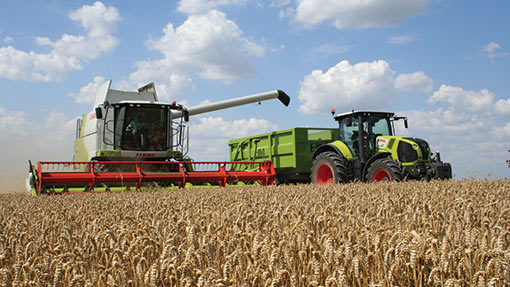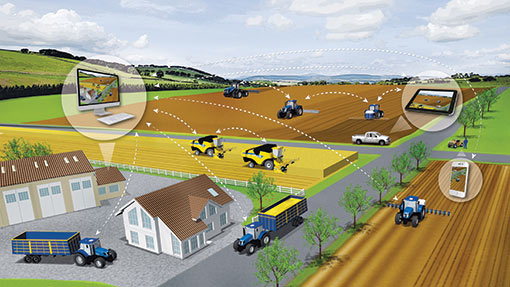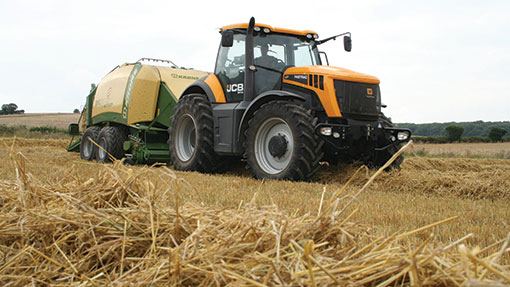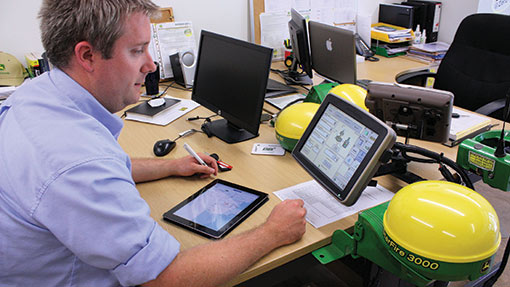How telematics is changing the way we farm

What could a jet airliner and a modern combine harvester possibly have in common?
OK, they both have wheels, windows and seats. But the more sophisticated connection is telemetry – a means of collecting data remotely that can be used to improve the way machines operate and drive down costs.
As the jet cruises 37,000ft above the Atlantic, data collected from sensors on the engines and other key systems is transmitted to a web portal accessed by maintenance engineers.
See also: GPS steering tops readers’ poll of best farm technology
Potential issues are flagged up so that the maintenance team can be prepared for a quick turnaround or inform the flight controller that a change of schedule will be needed for that particular aircraft.
Equally, as the combine works its way through a field of winter wheat, dealer service staff can monitor its health, as well as performance in the field. Dealers also now have the means to remotely access the operator’s in-cab screen, see what he sees and suggest adjustments to improve output or reduce losses. So what’s available out there?
Claas
Telematics offers a range of benefits, from relatively simple to highly sophisticated, says Edward Miller, Easy product manager at Claas.
“At its most basic level, a telematics system tells the owner where the machine is and what it’s doing, while providing the dealer with diagnostics information to help schedule servicing and prompt an alert if a problem arises,” he explains.
“At a higher level, it can be used for field efficiency analysis and automated field operation recording – which can be summarised as: ‘When did I start, when did I finish, and what did I do?’”
Claas was the pioneer of telematics for agricultural machinery and, 10 years on from its introduction on Lexion combines, the technology is available with the same level of capability to tractors.
“We now have between 350 and 400 systems in the UK,” says Mr Miller. “With a harvesting team costing typically £250/hour, anything that helps run it as efficiently as possible must be an asset.”
Next year, basic level Telematics 2.0 will be standard on Xerion, Axion 900 and Axion 800 tractors, and available for Arion 600 and 500 tractors. It will also be standard on Lexion 670 and 750 to 780 combines, the new Tucano 580 combine, and larger Jaguar forage harvesters.
“Our Telematics on Implements [Toni] system is also working well, and in addition to being available on Quadrant 3300 and 3400 big square balers, it’s being developed for Isobus-compatible machines from Amazone, Fliegl, Grimme, Horsch, Lemken and others,” adds Mr Miller.
On tractors and combines, Claas telematics is now structured into three levels of service and functionality, each with an annual subscription.
Basic provides the machine’s location, service diagnostics and so on, with Advanced adding machine settings, yield recording, job history and a two-day rolling record of utilisation data. Professional is equivalent to the current package, which provides full machine efficiency analysis and unlimited records.
“Automated documentation for online records is a bolt-on for all three and an app for mobile devices shows whether the machine is working or idle, its location and directions to it, and the fuel level,” explains Mr Miller.
New Holland

New Holland has opted for a two-level approach for the introduction of its PLM Connect communication system.
The Essential and Professional categories have the same core features of 24/7 machine data access and detailed machine analysis and evaluation. But while the former is intended for mid-size farms with tractors lacking CAN-Bus electronics, Professional needs the extra data this provides for in-depth, real-time information on tractors working locally or distant from the farm office.
“New Holland PLM Connect is the next best thing to sitting alongside the operator,” says Luca Mainardi, head of tractor and precision land management products. “Managers can use an online dashboard to monitor machine operations without the need to travel to different locations.”
Professional-level PLM Connect provides live communication with operators, providing the opportunity to provide experienced operator input to less experienced drivers to overcome problems and improve productivity.
“We’re aware that some farmers and contractors are reluctant to use modern connectivity systems,” adds Mr Mainardi. “A key feature of PLM Connect is its ability to evolve as the end user gains experience – maybe starting with basic monitoring, such as a locating a machine – before exploiting more of the system’s capabilities.”
Agco
The AgCommand telemetry package, available across Agco’s Challenger, Fendt, Massey Ferguson and Valtra product ranges, AgCommand has been updated this year with better reporting and a better search function within reports plus the option to “hide” machines not in use.
There is also a new mobile app giving access to more detailed historical reports, improved map view, navigation and weather radar, and better dealer access to the turn-by-turn directions they can use to locate a customer’s tractor or combine.
On Fendt tractors, VarioDoc Pro streamlines data logging directly into AgCommand to reduce the operator’s time spent transferring data.
“This update will make it easier for customers to see exactly what’s going on with their entire fleet across multiple brands,” says Bernard Schmitz, commercial manager for Agco’s advanced technology solutions. “It will help keep their machines running and in the right place at the right time.”
JCB

JCB emphasises the security and proactive maintenance aspects of its LiveLink telematics system, which is overseen by an operations team at the JCB World Parts Centre in Staffordshire.
It is fitted as standard to most farm-application JCB machines, such as the Loadall telescopic handler family, wheeled loaders and Fastrac tractors, and LiveLink Lite is available for retrofit to existing JCB machines and other makes of farm vehicle.
“Having created a geo-fence, owners will be alerted if their machine is moved beyond a specific location or outside working hours,” explains Edward Roach, JCB Agriculture product and marketing manager. “It is effective theft deterrence that’s proven to improve recovery rates, and brings the owner lower insurance premiums.”
JCB LiveLink also provides real-time machine location and status – whether vehicles are operating or stationary – and monitors the health of JCB vehicles.
“It provides more controlled management of servicing schedules, compiles activity records that can lead to more efficient machine usage, and provides early warnings of potential faults and other issues,” emphasises Mr Roach.
“Machines can be managed more effectively to help drive down costs, improve productivity and contribute to reliable service.”
John Deere

“We now have the ability to harvest large amounts of data and use it to make more informed decisions,” suggests Paul Burnett, John Deere territory manager. “That means lower tackle costs through more effective machine and business management.”
John Deere envisages dealer staff providing strategic advice on machine operation based on the analysis of customer telemetry.
“Getting the data is one thing, interpreting it and deciding whether changes would help is not for everyone,” says Mr Burnett. “But dealers with the right expertise could advise on things like harvesting routine or the use of auto-mode on tractor transmissions, or whether an operator needs specific training as part of their FarmSight service.”
“Dealers have always been looked upon as suppliers but the level of information and advice they can provide to professional operations means they are becoming consultants,” says Mr Burnett. “Data preparation and management services would add value by helping to get the final few percent of performance potential from the machines they supply.”
Deere’s JDLink telemetry options comprise an app providing driving directions and showing where a machine has travelled, Meanwhile JDLink Select provides operation, security and maintenance features for any make of tractor or combine and JDLink Ultimate provides the full-feature package exclusively for John Deere equipment.
Ultimate users can now subscribe to remote display access so that dealers and owners can see what the operator sees to guide through (but not change) on-screen settings for both Deere products and isobus-compatible non-Deere implements.
“If it saves someone travelling out to a field to resolve something that turns out to be quite simple, that’s a useful saving of a busy manager’s time and an opportunity to get machines working promptly,” he says.

